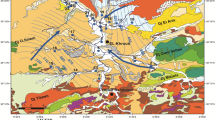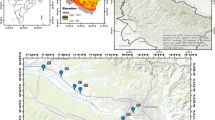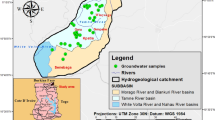Abstract
Conventional graphical and statistical methods were used with water quality indices to characterize the hydrochemistry of groundwater from the northern part of the Volta region of Ghana. The objective was to determine the processes that affect the hydrochemistry and the variation of these processes in space among the three main geological terrains: the Buem formation, Voltaian System and the Togo series that underlie the area, and to determine the suitability of groundwater from the area for drinking purposes. The Q-mode cluster analysis reveals three main water groups. The groups established from the Q-mode HCA appear to indicate different degrees of weathering which could further indicate varying levels of fracturing aquifer hydraulic properties. R-mode HCA and factor analysis (using varimax rotation and Kaiser Criterion) were then applied to determine the significant sources of variation in the hydrochemistry. This study finds that groundwater hydrochemistry in the area is controlled by the weathering of silicate and carbonate minerals, as well as the chemistry of infiltrating precipitation. Mineral activity diagrams for the CaO–Na2O–Al2O3–SiO2–H2O and CaO–MgO–Al2O3–SiO2–H2O systems plotted for the area indicate stability in the smectite field and attribute hydrochemistry to the weathering of silicate minerals. Silicate mineral weathering and the effects of precipitation appear to be pervasive among all the three main geological terrains, whereas carbonate weathering is localized among the Voltaian aquifers. Cation exchange does not appear to play a significant role in the hydrochemistry but mild Water quality indices (WQI) were calculated for the samples using the concentrations of Na+, Ca2+, Mg2+, Cl−, NO3 −, F−, and EC at the various sample locations. The WQI values indicate that groundwater from the study area is of excellent quality for drinking purposes. WQI values from groundwater samples are averagely higher than samples taken from surface water sources in the area. This implies that geology has had an impact on the WQI of groundwater in the area.










Similar content being viewed by others
References
Alberto WD, Del Pilar DM, Valeria AM, Fabiana PS, Cecilia HA, De Los Angeles BM (2001) Pattern recognition techniques for the evaluation of spatial and temporal variations in water quality: a case study, Suquia River Basin (Córdoba-Argentina)
Appelo CA, Postma D (1993) Geochemisry, groundwater and pollution, 2nd edn. Balkema, Rotterdam
Chebotarev JI (1955) Metamorphism of natural waters in the crust of weathering. Geochim Cosmochim Acta 8:22–48, 137–170, 198–212
Dickson KA, Benneh G (1985) A new geography of Ghana. Longman, UK
Drever JI (1988) The geochemistry of natural waters. Prentice-Hall, Upper Saddle River
Farnham IM, Stetzenbach KJ, Singh AK, Johannesson KH (2002) Treatment of nondetects in multivariate analysis of groundwater geochemistry data. Chem Intell Lab Syst 60:265–281
Güler C, Thyne GD (2004) Hydrologic and geologic factors controlling surface and groundwater chemistry in Indian Wells-Owens Valley area, southeastern California, USA. J Hydrol 285:177–198
Güler C, Thyne G, McCray JE, Turner AK (2002) Evaluation and graphical and multivariate statistical methods for classification of water chemistry data. Hydrogeol J 10:455–474
Helgeson HC (1969) Themodynamics of hydrothermal systems at elevated temperatures and pressures. Am J Sci 267:729–804
Helgeson HC (1970) Description and interpretation of phase relations in geochemical processes involving aqueous solutions. Am J Sci 268:415–438
Helsrup T, Jørgensen NO, Banoeng-Yakubo B (2007) Investigation of hydrochemical characteristics of groundwater from Cretaceous–Eocene limestone aquifer in southern Ghana and Togo using hierarchical cluster analysis. Hydrogeol 15:977–989
Jalali M (2007) Hydrochemical identification of groundwater resources and their changes under the impacts of human activity in the Chah Basin in Western Iran. Environ Monit Assess 130:347–364
Kaiser HF (1960) The application of electronic computers to factor analysis. Educational Psychol Meas 20:141–151
Kortatsi BK (2006) Hydrochemical characterization of groundwater in the Accra Plains of Ghana. Environ Geol 50(3):299–311
Kuells C, Adar EM, Udluft P (2000) Resolving patterns of ground water flow by inverse hydrochemical modeling in semi arid Kalahari basin. Tracers Model Hydrogeol 262:447–451
Norton D (1974) Chemical mass transfer in the Rio Tanama system, west-central Puerto Rico. Geochimica et Cosmochimica Acta 38:267–277
Nti E (2005) Hydrochemical and isotopic characterization of groundwater in the Buem, Voltaian and Togo formations of the Volta Region, Ghana. MPhil Thesis, University of Ghana, p 168
Sahu P, Sikdar PK (2008) Hydrochemical framework of the aquifer in and around East Kolkata wetlands, West Bengal. India Environ Geol 55:823–835
Statistixl (2005) statistixl 1.5 Broadway-Nedlands, Western Australia, Australia, http://www.statistixl.com. Retrieved 28 October 2007
Thyne G, Güler C, Poeter E (2004) Sequential analysis of hydrochemical data for watershed characterization. Groundwater 42(5):1–12
Yidana SM, Ophori D, Banoeng-Yakubo B (2008a) Hydrogeological and hydrochemical characterization of the Voltaian Basin: the Afram Plains area. Ghana Environ Geol 55:1213–1223
Yidana SM, Ophori D, Banoeng-Yakubo B (2008b) A multivariate statistical analysis of surface water chemistry–The Ankobra Basin, Ghana. J Environ Manag 86:80–87
Author information
Authors and Affiliations
Corresponding author
Rights and permissions
About this article
Cite this article
Banoeng-Yakubo, B., Yidana, S.M., Emmanuel, N. et al. Analysis of groundwater quality using water quality index and conventional graphical methods: the Volta region, Ghana. Environ Earth Sci 59, 867–879 (2009). https://doi.org/10.1007/s12665-009-0082-9
Received:
Accepted:
Published:
Issue Date:
DOI: https://doi.org/10.1007/s12665-009-0082-9




